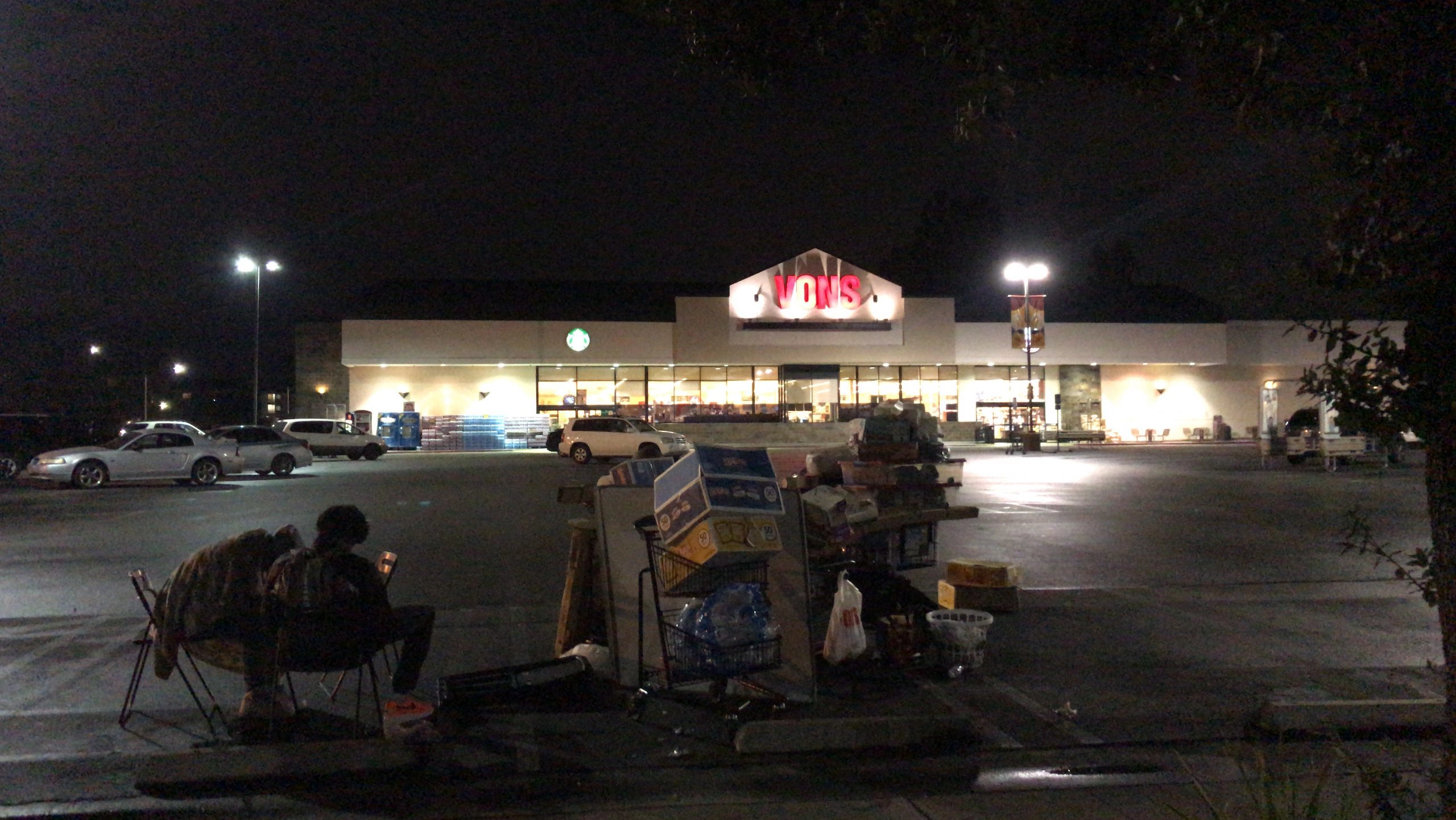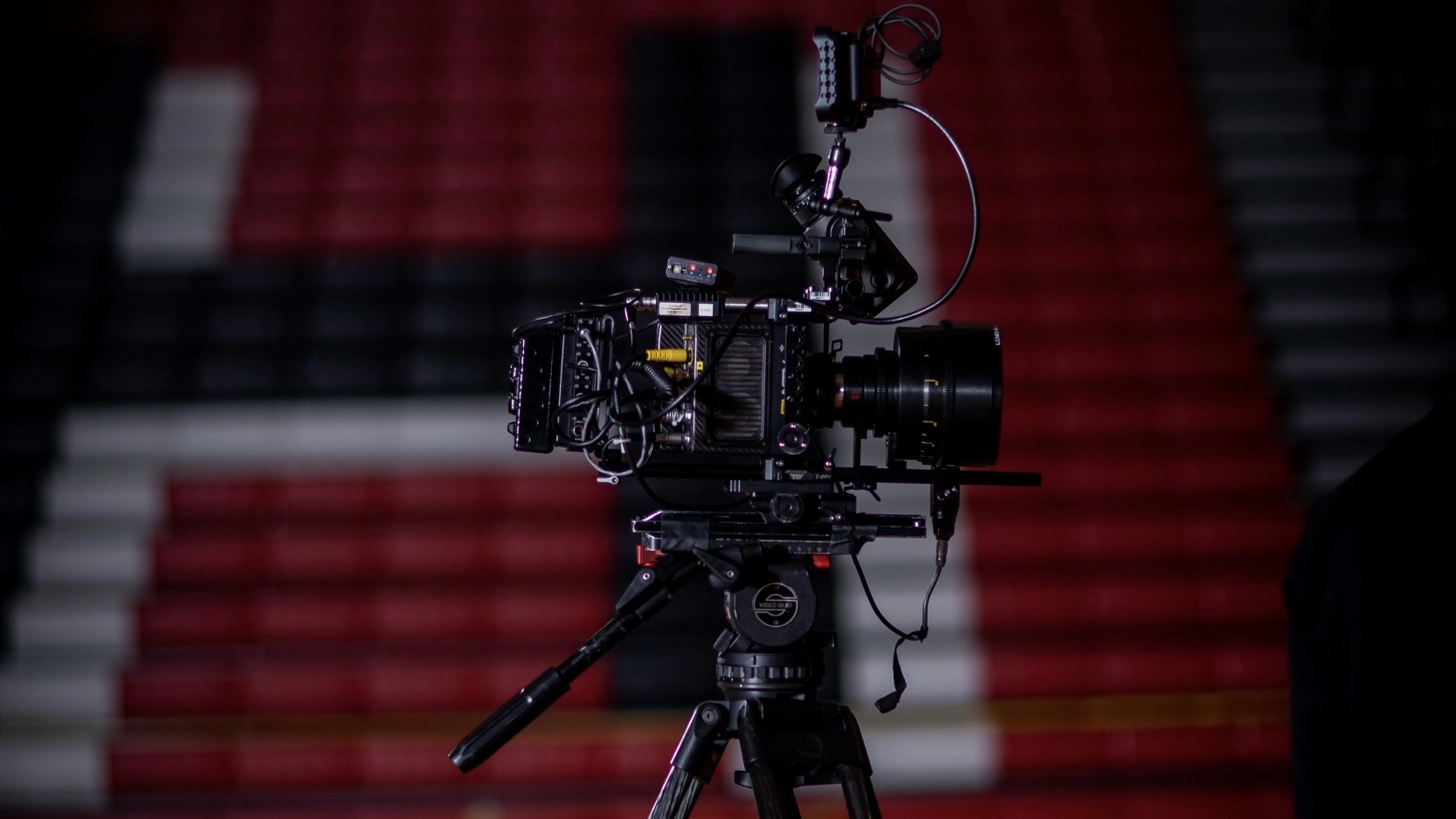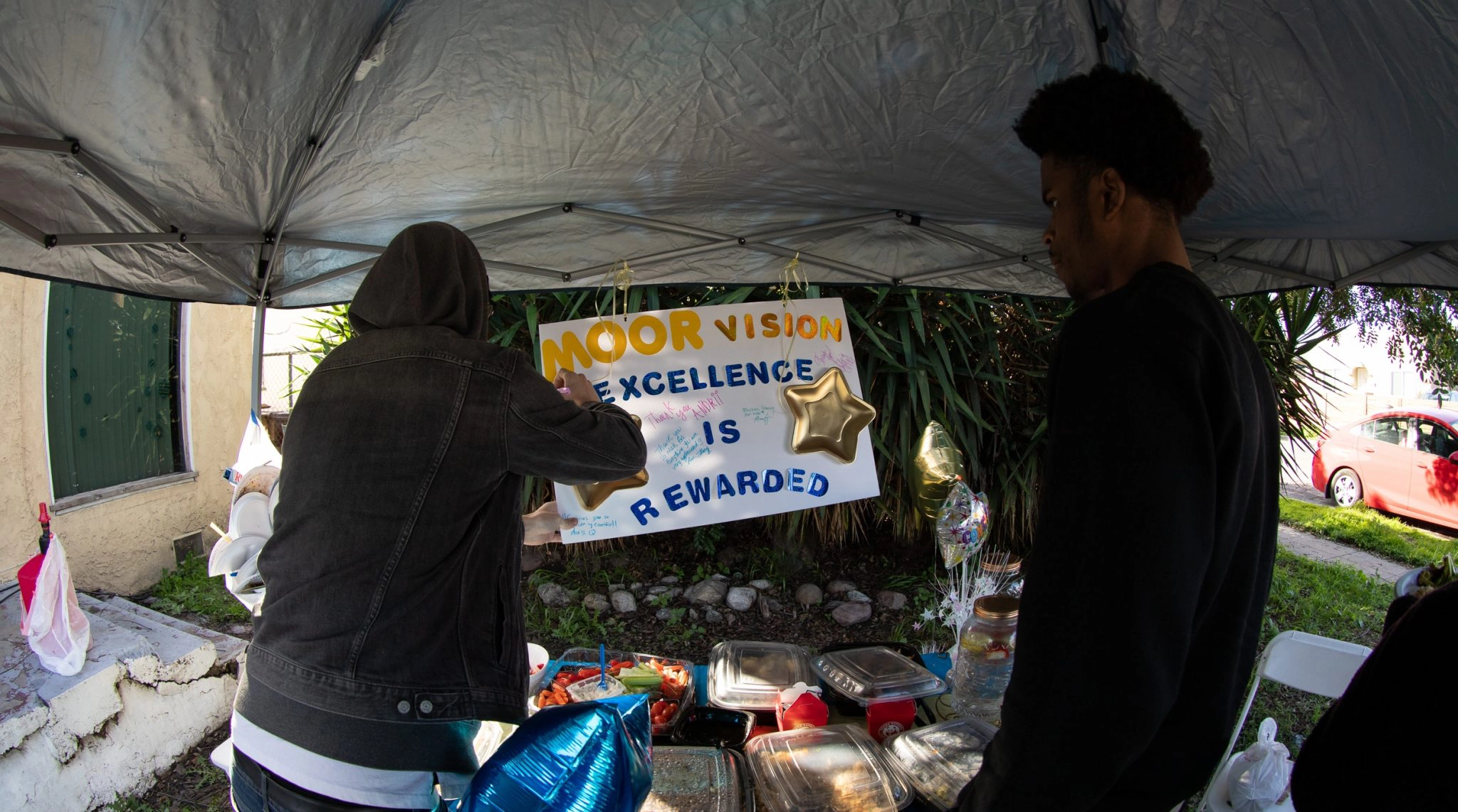The lowest point we hit during the production was when we had extended the production for another week, and I just got home from a very long day on set. It was around 9pm, I get a call from our truck rental company, and the guy is telling me that they made a mistake and the insurance didn’t cover that extra week we had just extended the production, and hence, the truck for. So now they have to take the truck back. That very moment.
Keep in mind, we still had to shoot the next day at 6AM, we still needed half of the things in that truck, and on top of that, this truck was our transportation from Burbank to Compton. But we really had no choice, we had to give it back to them. So now it’s past 10PM, we’re in the parking lot of Vons, with boxes of snacks, cases of water bottles, props, chairs, bounce boards and other things, and no form of transportation to get it all to the set tomorrow. We looked up the only open U Haul rental, all the way on the other side of Burbank, and went there (Jordan, our artist at the time, who was with us for the whole shoot, stayed in the parking lot to watch over everything).
We got there, only to realize that it wasn’t open. It was very cold outside, so now, devastated, we went to the bar right across the street to see what else we can figure out right now. Inside this bar, this old white owner now kept coming up to us and trying to talk to Rah and joke around, and eventually told us to “get the fuck out”. It was very hard to keep our cool in that moment, but we did, and we left and returned to our stuff in the parking lot. It’s around 2AM now, freezing cold, we’re stuck with all these things around us, and we have to be on set in a few hours.
For about an hour we just sat there, looking for a solution. We decided to throw some things away, and Uber the rest to our places. We didn’t sleep that night, and could only get a U Haul around 8AM. Now the truck that was given to us broke down on its way to Compton. Very bad luck. When we finally got everything to the set around 11:30AM, the crew was very upset, and long story short, we just decided to wrap the shoot right there and then, take a break, assess everything we did wrong and everything we did right, and come back and finish the movie with a different approach. The movie was about 70% filmed at that point. Obviously, we bounced back, and the movie is now finished and released.

So what does a film producer actually do?
In one word: facilitate.
I’ve done producing work-for-hire before, and produced 17 micro-budget shorts, but Rah and I haven’t yet done a single project of our own with a budget. We did a couple web series pilots and some videos for Bone Collector at that point, but we made all of that happen off pure hustle, and with $0 budgets. There’s a huge difference between producing your own project, and producing a project for someone else.
Producing your own project independently is like being a general manager, head coach, point guard and an owner of a basketball team. You get to decide who you add to the roster, who the assistant coaches are, if you wanna add a backup point guard, the playbook, how the payroll is spent… You get the point. At the end of the day, all of the responsibility and decision making is on you.
Producing a project for someone else – the team owner (executive producer) handles quite a few of those responsibilities and decisions instead of you, or hires others to share the responsibilities with you, at least that was my experience prior to producing “Bompton Had a Dream”.
The film producer is responsible for the production top to bottom. It all starts with the most difficult and most crucial step of bringing any project to life: acquiring funding. In our case, we were considering doing a short at first, and Rah was working on a script based on a play he wrote in high school, while I budgeted to produce it for $25,000. But when Rah finished the first draft of the script, it was over 150 pages, obviously far too long for a short, so he rewrote it, and then rewrote it again, and then rewrote it again, and now it was 90 pages. We both liked that version of the script enough to not want to see it any shorter, and we were now having a conversation about why were we even considering doing a short in the first place. Sure, it’s easier to make a short, but we both felt like if we took on that challenge of producing a feature, we could make it happen. So we said “Let’s do a feature.” Of course, $25,000 is ambitiously low for a feature, especially considering the quality that we were going for, but with certain sacrifices and smart planning, it made sense. Then, we were blessed enough that my good friend and former business partner Petru Chirtoaca closely monitored what I was up to during my time in LA, and he believed in us enough to give me a call and inquire about investing in making a film. Rah and I pitched him “Bompton Had a Dream”, and he instantly liked it. So after a couple of months of me and Petru figuring out the business specifics, we closed the deal.
After locking in the financing, one of the next steps that the producer is responsible for is hiring the crew. This one here is one of the biggest lessons I’ve learned – potential crew member’s skill level is not the most important factor. I personally made a mistake of not really vetting out the crew and delving deep into how much can they really understand this story, this world we’re about to bring them to, and how passionate are they about seeing this story be told. Instead, I approached it from the affordability perspective, with each new committed person being a subtraction from the budget and checkmark on the “Filled Positions” list. Needless to say, I’ve learned that that’s not the right way to approach it.
We made it one of our priorities to separate ourselves with the quality, so a big chunk of our budget went to the equipment – Rah had decided on shooting with the industry standard Arri Alexa Mini, and the DP picked the Lomo Anamorphic Lenses. That’s what really defined the look of our film.

We understood where we initially went wrong with the hires, so for the last re-shoots we had a completely new crew, and everyone was really understanding and genuinely determined in seeing this story be told and this film get done. One particular situation occurred that really made all the difference – we were wrapping up the last day of the re-shoots, we’re about to go into overtime, and we haven’t even got started on the last scene. When we got to the location, we couldn’t get inside, and the owner of the place tells us he’s being held back at work, and he’ll only be able to open it up in a couple hours. It’s already 7:30 pm, so I start stressing, and come up to our DP David, apologizing for the delay, and asking if it’s fine with him to wait… He was like: “Hey, it’s ok. I’ve been there. Things like this happen all the time, don’t worry. I wanna get this movie done with you guys.” Everyone else on our crew matched his energy. That was a huge relief, because as a producer, team’s morale is always on your mind – you don’t want anyone to be frustrated or angry while working by your side, and to know that the whole team got your back makes all the difference.
A few industry producers told me that one of the most important first hires for a production is a great casting director, because of the great talent this individual can add to the cast, and hence improve the quality of the picture and make it more marketable. I believe it’s less important for smaller productions, considering how tight the budgets can be, so paying an extra salary to a casting director and trying to cast more or less established actors would unnecessarily eat up a significant chunk of your budget. If you’re the producer, and you know what you’re doing, you believe you have an eye for talent, it makes a lot more sense for you to organize the casting calls yourself, and, along with your director, sit through each casting session until you find exactly what you’re looking for. There’s a sea of talent out there, and just because most of the actors that you’ll have to consider don’t have a big time agent or a stacked resume, doesn’t necessarily mean they won’t be the best possible fit for that role.
For our production, I was handling casting. That was easily one of my favorite things to do – you get to meet a lot of great talent, and reimagine each role so many times over, depending on the actor that comes in the room. I know Rah had a lot of fun with that. In fact, when we were casting for Saav, right before Avery Gregory came in for the audition, the actor before him, Pedro Louis, came in for the same role and absolutely killed it. Everyone at the table loved him, and he instantly became the favorite for the role – only issue was that his look was a little more mature than who we already had for Javon and Phoolie. So when Avery came in and booked the role, we didn’t want to leave Pedro out of the project. We talked about it for a second, and we came up with an idea to write in a character specifically for Pedro.
Also, I’d like to note that the performance that you see on-screen shan’t only get credited or blamed on the actor, since the director plays a huge role in how the performance comes out. I’ve been on quite a few sets where the director was clinging on to his or her initial idea of how the character should be, and not re-adjusting and catering to the their actor’s personality and range. I’ve been on multiple sets where I saw actors get frustrated with the director’s uncertainty with how they want the scene to come out. I wasn’t there for all of Rah’s rehearsals with the cast, but for the ones I was, I could observe his individual approaches and how well he communicated with each one of them, and how much the actors have grown into their characters. I personally believe that as much credit as the actors deserve for their final performance, equally as much credit should be given to Rah for how hard he worked with them throughout the process, and I think he did a remarkable job.
Don’t undervalue the production assistants! Most of the days we could’ve used at least a couple more on our set. So many times I had to personally handle things that could’ve been easily taken care of by just a couple more production assistants. Committed PAs are the difference makers for productions of every scale.
Outside of the initial crew that we hired, Rah and I took on many more responsibilities outside of just being a “Director” and a “Producer”. Costume design is very crucial to picture’s look and viewer’s perception of each character, and since Rah clearly knew how he saw each character, he was handling that. Most productions would usually have a location scout, but we wanted to personally feel every location, so we just took care of that ourselves. Starting with Centennial High School, where we met Twinn, who connected us with Wacko, and Wacko took us on a tour around Bompton. We told him what we were looking for in each location, and he showed us just the perfect places.

Along with our 1st Assistant Director, I developed a production shooting schedule, and I honestly thought that we did an amazing job… And then the rain ruined it all. Thinking about it now, and blaming myself for settling to shoot in February, the threat of the rain wasn’t even a thought. I mean, it’s LA. It only rained like 3 hours total through the year that I’ve lived there, and before that, there was a drought in California since 2011. So these anomalous heavy rains that went on for weeks have definitely caught us off guard.
Although rains like that in LA were very unlikely, still, I think it would’ve been much smarter if the principal photography took place in June or July instead of February. The sunrise would’ve been at 5:40AM-6:00AM instead of 6:40AM, and the sunset would’ve been at 8PM instead of 5:30PM, hence giving us around 2 extra hours of sunlight each exterior production day (which was 70% of the shoot).

When your picture reaches the post production stage, and the film is getting edited, and you finally get to see how all those scenes that you filmed in a non-linear order fit together and tell your story, it’s important to not get too comfortable admiring the work you’ve done like, “damn, we really shot this movie”, and not to cling on to alright and subpar footage, just because it’s already filmed and because of the tight budget. We had quite a few scenes that were complete and fine, but we knew that if we re-shot them, we could get them to come out better. If your picture has room to improve, and you have an opportunity to make it happen, don’t hesitate. Our movie is not perfect by any means whatsoever, but for the budget and opportunity we had, we stopped at nothing to make it the best possible picture.
When the film was finally fully edited and colored, our post sound guy dropped out last minute, and we were planning to release the film in a few days at this point. I had some experience with sound, so I took it upon myself to do sound editing & design. I was determined for us to put the movie out by our target date, so I did the whole sound top to bottom, in two straight days with no sleep.
Being that the producer is in charge of the production and all responsibilities fall on you, you have to constantly handle problems and maintain serenity on the set. Me producing this film all by myself, there were seldom any moments when I wasn’t either on the phone, or politicking with someone in person. Obviously, for a production to flow as smooth as possible, the communication between everyone has to be immaculate. There were moments when certain actors were late to the set, and I’d be calling them and they purposely wouldn’t answer the phone, I guess because they thought I’m about to be an asshole to them. But in reality, as I’ve clarified with them, it’s only so many hours you have each production day. So if your presence is crucial to the next scene we’re about to shoot, and you’re not here for it yet, you need to let me know if you’re either around the corner, and we should wait on you, or if something unexpected came up, and you’re not gonna be able to be on set for at least the next 3 hours, so we can adjust our plan, and figure out if we can shoot something else until you arrive.
The final budget for “Bompton Had a Dream” was around $45,000, and the initially planned principal photography (between Feb. 2nd – Feb. 18th) cost us about $27,000. But the above mentioned rain robbed us of about 7-8 of those days. The very first day of the shoot completely went to waste because the DP forgot that the lense we were using blurred up the image at the top, and that ruined majority of the crucial storytelling shots, so we had to reshoot all the scenes from that day.
We had back-to-back days scheduled for a scene in the park, and a couple young G’s from the area didn’t know anything about our film shoot, so when they saw a dude who was playing a Crip in our film outfitted in all blue, with blue rag around his neck and two more hanging out his pockets, they pressed him. By the time the situation got resolved, the actor decided to quit the project because he feared for his life. So all the footage we got with him had to be re-shot, and his character had to get re-casted. Because of all of the above mentioned struggles, and so many more things that I haven’t mentioned, because even the “good” days weren’t problem-free, probably about $13,000-$15,000 from that initial $27,000 went to waste.
I think it’s great that we challenged ourselves to make our first full-length feature film for $45,000. We had to get creative with how we approached certain situations, and the rookie mistakes cost the production a lot less financially compared to what it could’ve been if we had a bigger budget. From the producer’s eye, I really got to see what matters most for the production to function like a well-oiled machine.
One thing that stuck with me that an industry person said to me, was that the ability to finish is one of the things that matter most when assessing you and your accomplishments. Many people get stuck with an idea and struggle to take it off the ground because of the fear of taking a risk on their endeavor, many give up half-way through the process, because things get too stressful and too challenging.
After intensely preparing and making sacrifices for this project for months, during the very first day, when we were falling behind schedule, this rain was only getting crazier, the efficiency and preparation wasn’t meeting my expectations, and, of course, as a producer, I felt like most of that was to blame on me. I remember for a brief moment, I put my head down, and Rah caught that and said to me “Don’t let all of this stuff get to you, man. No matter what happens down this road, just remember that we’re gonna come out of any situation back to back. Just like we always have. Come on now. Let’s get to work.” One of the days on the set I was on a phone talking to a friend in the industry, I told him about some of the problems we were experiencing, and he said to me “every time you speak of something negative, you give it a heartbeat. You can’t give negativity life on your production.” And he was right, you gotta make sure everyone on the set remains positive, especially the leaders. Even if you’re an optimist by nature, like I am, you’re still human, and problems can get to you sometimes. We have invested so much of our heart and energy into this project, from driving to sets at 5AM, coming back home past 10PM, being on the phone with Rah and the DP going over the game plan for tomorrow, making sure everything is in order, checking the weather forecast, and so on and on, and now it’s 2-3AM, I gotta be on the road by 5AM again, so there’s really no room to rest, especially considering how much is on my mind. So Rah and I really went days and days without real rest and sleep during the production. All of that, combined with all of the problems results in some level of mental fatigue, no matter how tough you are. But that’s what comes with the territory when you’re trying to do something great. Regardless, you can’t give negativity any life, or let it be seen in your presence or communications with your team, especially as a leader. Because nobody wants to follow a pessimist.

We locked in the funding in September 2018, and the movie released in April 2020. That’s far behind the schedule we had in mind, the movie is certainly not perfect, but it got finished. It came out. And I’m very proud about how it came out and the reception we’ve been getting. Moreover, I’m very happy and grateful for every bit of the process, including all the challenges and struggles that we had to face, because now when we do our next projects, we’ll be prepared.
I think, as a producer, it’s very important to appreciate and enjoy how much impact you have on how your art comes out. Every single decision you make for the production can lead the final picture to come out one way or another. I get so happy about every little victory, every small milestone, and achievement, because like the late Great Kobe Bryant once said, “It’s not the destination, it’s the journey that’s the dream.”
